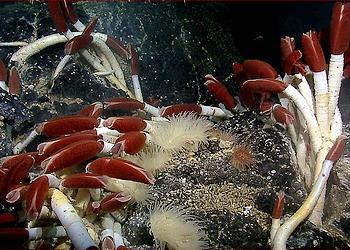
NEW YORK, New York, January 27, 2015 (ENS) – Government representatives from around the world agreed Saturday to develop the first legally-binding agreement to conserve marine life in the high seas and international seabed, an area covering roughly half the planet.
After four days of intense deliberations at UN Headquarters in New York, delegates reached consensus to begin negotiating a UN treaty that addresses the protection of marine life in areas beyond national jurisdiction – the global ocean commons.

Delegates leaving the UN in the midst of a blizzard that hit New York early Saturday morning were excited about reaching consensus on starting negotiations towards a new legally-binding instrument.
The ninth meeting of the Ad Hoc Open-ended Informal Working Group on Biological Diversity Beyond Areas of National Jurisdiction was attended by some 200 participants, including national delegations, intergovernmental organizations and nongovernmental organizations.
The meeting was the last of three convened by the UN General Assembly over the past nine months to discuss the scope, parameters and feasibility of a possible new international instrument on the conservation and sustainable use of marine biodiversity in areas beyond national jurisdiction, BBNJ, under the UN Convention on the Law of the Sea, or UNCLOS.
The meeting produced recommendations for a decision to be taken during the current session of the UN General Assembly on the development of a new treaty under UNCLOS, as mandated by the 2012 UN Conference on Sustainable Development, informally called Rio+20.
The conservation and sustainable use of biodiversity in areas beyond national jurisdiction is attracting increased international attention. Areas around seamounts, hydrothermal vents and cold-water coral reefs are rich in biodiversity but vulnerable to damage by human activities such as fishing and bioprospecting.

Karen Sack of the nonprofit Pew Charitable Trusts said, “This is a big moment for the high seas. Countries from around the world sat down and agreed to negotiate a way forward, and that’s really good news for life in the global ocean.”
At the meeting progress came despite pressure from a small group of governments that questioned the need for a new legal framework. That minority blocked agreement on a faster timeline reflecting the clear scientific imperative for action, but all countries agreed on the need to act.
As an assurance to high seas fishing states, it was agreed that any new treaty would not undermine existing agreements or the work of relevant international bodies.
John Hocevar, Oceans Team Leader for Greenpeace US, said, “This was a historic moment for the oceans, with the final agreement coming down in the wee hours of the morning. When the U.S. joined with the majority, the last remaining holdouts followed along.”
“Now that the international community has agreed to protect the high seas, hopefully they will pick up the pace and get this process moving before it is too late for our oceans,” said Hocevar.
The outcome of the meeting must now be adopted by the UN General Assembly by September 2015, during the current session.
A formal preparatory committee will start work in early 2016 to develop the elements of a draft treaty. Though no end date to the negotiations was agreed, the UN General Assembly is to make a decision by September 2018 on the convening of an intergovernmental conference, under the auspices of the United Nations, to finalize and adopt the text of a treaty.

“Though the final results remain uncertain, many have high hopes for the new treaty,” says Kristina Gjerde, senior high seas advisor iwth the International Union for the Conservation of Nature.
“It could help secure the designation of a truly global system of marine protected areas, mainstream biodiversity conservation into the governance of high seas fisheries, shipping and seabed mining, and provide for more effective access to marine genetic resources,” Gjerde said. “The treaty could also also foster important new scientific and commercial discoveries while ensuring the benefits are shared by all.”
Although many conservationists were disappointed that the recommendation did not designate a date for convening of an intergovernmental conference, the meeting did succeed in charting the way forward for negotiations and, for the first time, reaching consensus on the legally-binding nature of a future agreement on the conservation and sustainable use of BBNJ.
Mission Blue’s Dr. Sylvia Earle, an oceanographer, said, “Armed with new knowledge, we are taking our first steps to safeguard the high seas and keep the world safe for our children.”
Sofia Tsenikli of Greenpeace urged, “Countries now must respond to the overwhelming public demand for better ocean protection and develop an historic agreement for the oceans. Time is of the essence.”
As reported by the Earth Negotiations Bulletin, the U.S. delegation pointed out that difficult questions remain unanswered: could a fish be considered a marine genetic resource? Who in the very long chain from basic research to product sales would be required to share benefits: the end user, the state of the end user, the seller, the state of the seller? And to whom would any benefits go and on what basis would they be distributed?
Lisa Speer of the Natural Resource Defense Council is hopeful that these and many other outstanding issues can be resolved, saying, “Many States have shown great efforts to protect the half of the planet that is the high seas. We know that these States will continue to champion the urgent need for more protection in the process before us.”
Aurélie Spadone with IUCN’s Global Marine and Polar Programme said, “A legally-binding treaty for our global ocean commons is essential to build a healthy, resilient and productive ocean for the benefit of us all, future generations included. Indeed, for the two-thirds of the ocean beyond national jurisdiction, international cooperation is the only way forward.”
Copyright Environment News Service (ENS) 2015. All rights reserved.
© 2015, Environment News Service. All rights reserved. Content may be quoted only with proper attribution and a direct link to the original article. Full reproduction is prohibited.
